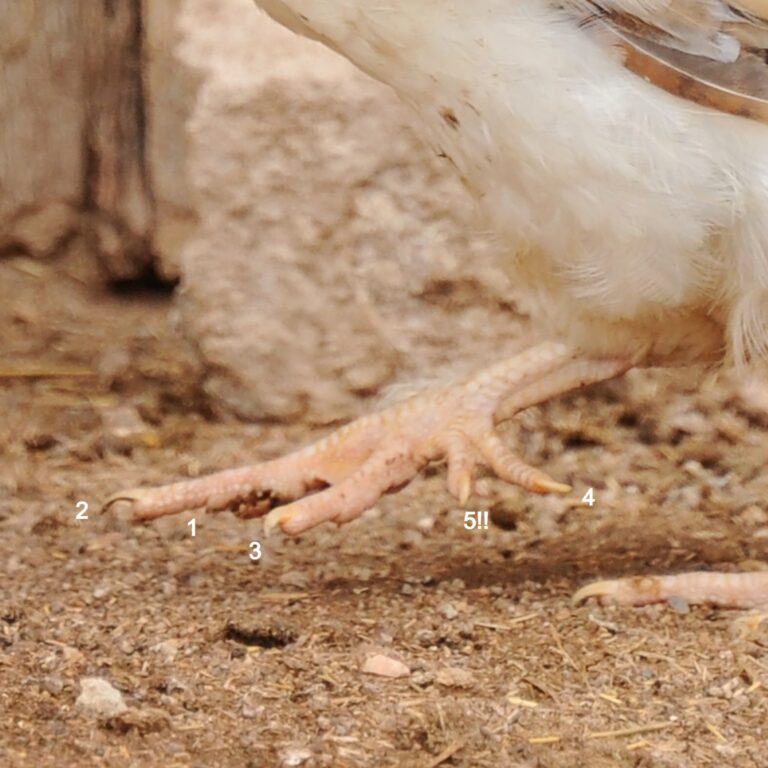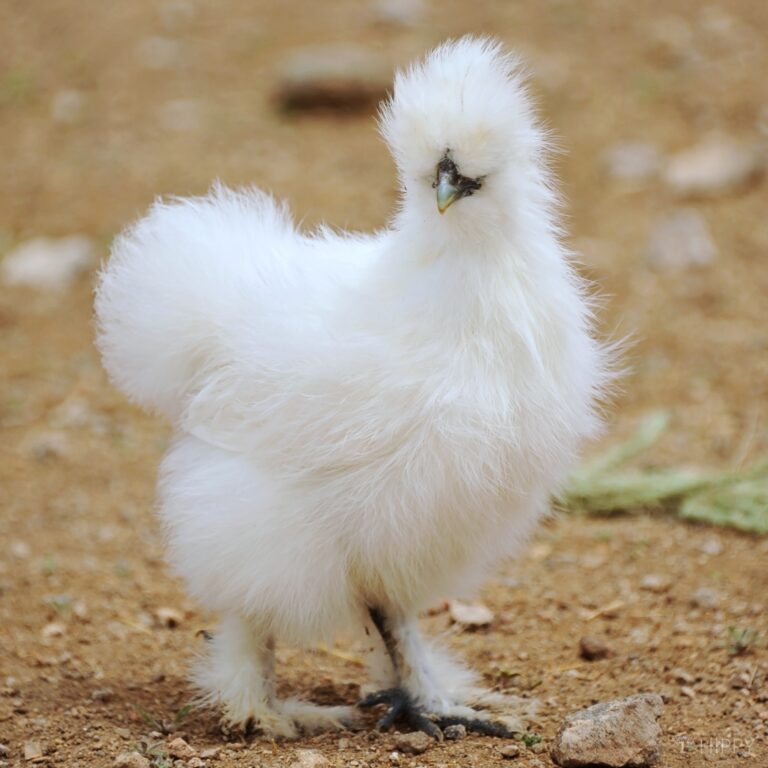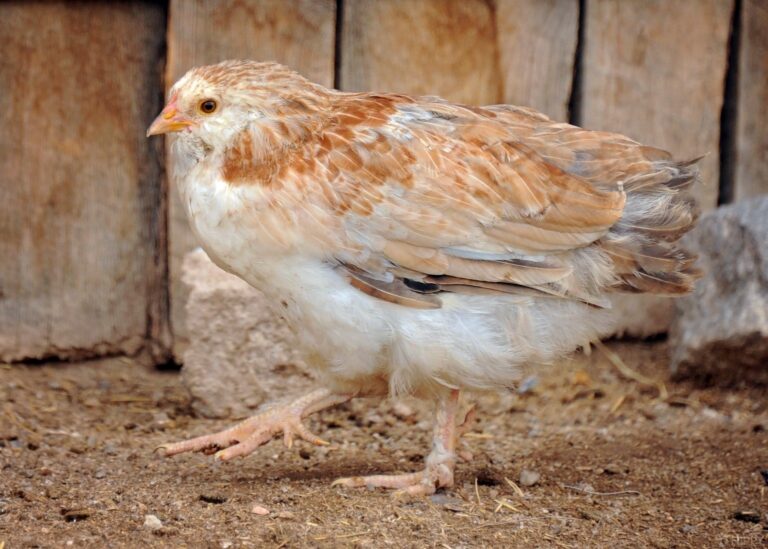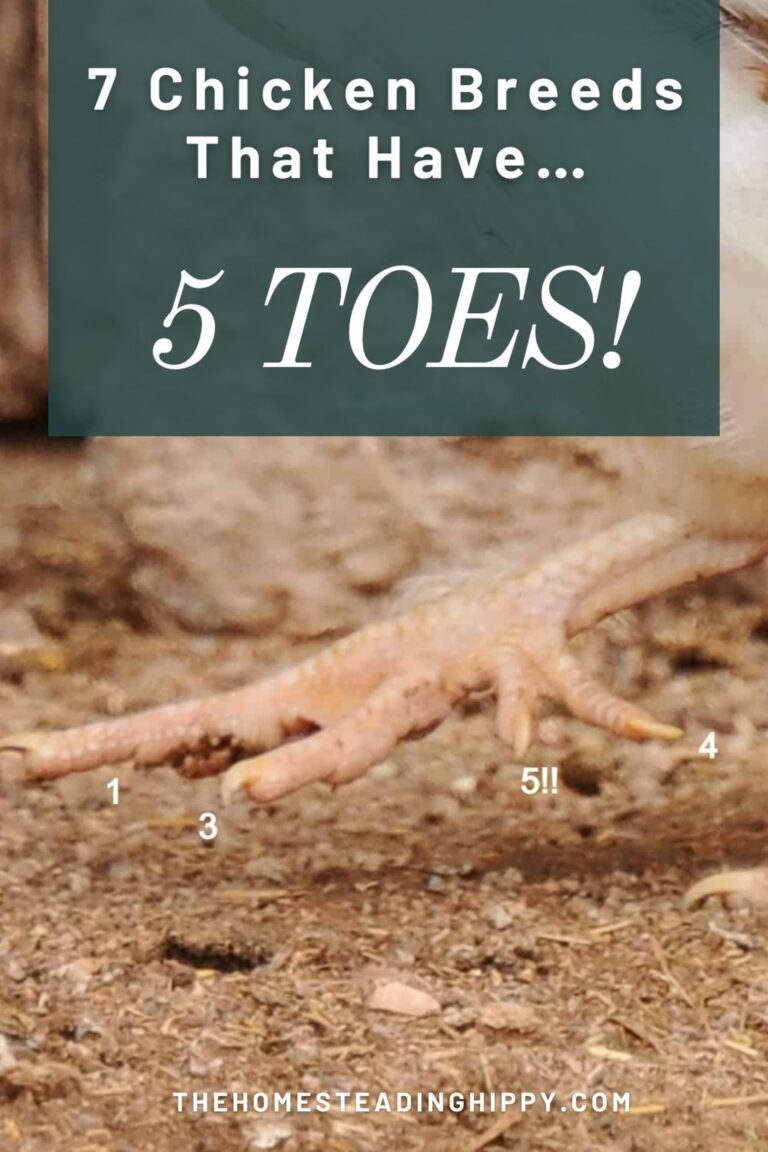If you’ve spent any amount of time around chickens, you are probably already familiar with their typical physiology and body plan. Comb, wattles, beak, long neck, plump body, short wings, legs, and four toes on each foot. Simple as. Except, wait a second, does that chicken have 5 toes? It does, and on each foot!

If you didn’t know any better, you might think you were going a little crazy, but hold off on that appointment with the therapist for a minute. A few chicken breeds do indeed have 5 toes as a rule, and it isn’t necessarily a defect.
If you want to learn more about 5-toed chickens I’ve got a few breeds to tell you all about down below.
Why Do Some Chickens Have 5 Toes?
Some chickens have 5 toes on each foot, as opposed to the usual four, due to a genetic condition known as polydactyly. This condition results in extra digits on each foot, sometimes on top of or immediately branching off of one of the other toes, and other times forming a separate and otherwise normal digit.
Why this occurs in various chicken breeds, it’s really just a quirk of genetics: essentially this trait has been passed down over the countless generations of chickens that have been bred and, in the breeds that do feature it, is now considered a standard of the breed.
Any such birds on our list below that lack it, unless otherwise specified, would be considered abnormal.
On the other hand, it isn’t impossible that other chicken breeds could show polydactyly, and in the same way, this would be considered a defect for them if all they are supposed to have is four toes.
Short, if you own any of the chickens on the list below and they have 5 toes on each foot, don’t worry about it. If any other chickens have 5 toes, it should be considered quite remarkable!

Silkies
Silkies are among the most beloved chickens out there, and they’re instantly recognizable from their plush, frizzy, and soft feathers which look almost like the fur of a mammal.
That, and their striking black skin, a trait that’s shared with few other breeds. This is a crested breed, though theirs is a bit more conservative than some others and they typically have 5 toes on each foot as standard, though ones with 4 toes per foot are not unheard of.
But, uniquely, Silkies are known for occasionally growing a sixth toe! Though instances of this extreme polydactyly are somewhat rare, it is more common with Silkies than nearly any other breed.
Every now and then, a Silkie might grow an extra digit inside or alongside of one of the others, meaning they could have a single, larger toe that is somewhat malformed.
Depending on the governing poultry association in your area or country, the number and arrangement of extra digits may or may not be considered a defect in the breed, but it’s totally normal, so you need not worry about it otherwise.
Silkies are tiny bantams, and weigh a little over 2 pounds as a rule, though some impressive roosters might reach 3 pounds.
And as with most bantams, they’re really an ornamental breed or pet, because they produce very little in the way of meat and, like the typical silky, they aren’t great layers and what eggs they do lay yearly are very small. It would take a bunch of silky bantam eggs to make a halfway decent omelet!

Faverolles
A gorgeous and distinctive French breed, Faverolles have a reputation for being inquisitive and almost playful, and also quite vocal, a characteristic which will either endear them to you or aggravate you depending on your preferences.
They were originally developed to tolerate confinement better than the typical commercial birds of the day (which happen to be the next chickens on our list), a trait that they still exhibit in our era. Faverolles really won’t get stressed until they’ve been cooped up in close quarters for quite a long time.
This is another dual-use breed capable of producing plenty of meat and a good amount of eggs, averaging about 200 yearly. A heavier medium-weight chicken, these birds usually weigh about 7 ½ pounds or a little less for roosters, with hens being only somewhat lighter around 6 pounds.
Aside from their 5 toes, their appearance is also distinguished by their typical striking salmon coloration, frizzy beards and muffs, and feathered legs. Truly a unique breed, and one that’s well worth looking into as an addition to your flock.
Houdan
Another French breed, a couple of hundred years ago this used to be the predominant commercial chicken that was raised in that country for both meat and eggs.
Like the Faverolles that replaced it in most regards, the Houdan also has 5 toes on each of its feet as a standard breed feature.
And as alluded to above, the Houdan does not tolerate confinement well, and part of that is because they are big, stocky, and thick birds, typically weighing more than 8 pounds and some clearing 9.
Although they aren’t as well known today compared to the Faverolles, they are still an important heritage breed. Sadly, though, they are on the decline and rarely seen.
Other distinctive physical characteristics include an upright and chisel-shaped tail and a large crown of feathers along with a subtle beard. Like most crested chickens, they tend to be a bit neurotic and edgy, but they tend to be friendly and good with people as long as they know them.
Dorking
Dorkings are one of the many heritage breeds hailing from the UK, specifically from the Dorking region. But compared to many heritage breeds, the Dorking is actually ancient, and there are records of it going all the way back to Roman and pre-Roman times. It exists pretty much the same today as it did back then!
Long utilized as a big, stout bird capable of producing plenty of meat, today it is a true dual-purpose breed, producing plenty of eggs, usually in excess of 180 a year, and still lots of tasty, high-quality chicken that is fit for the dinner table.
They are known to be mostly independent, but generally friendly and good-natured by their owners. If you want a chicken that is a capable forager, you’ll be pleased as they certainly enjoy having room to roam and find choice bugs and other bits of food.
These beefy birds don’t mind having the extra toe either: they are quite sizeable, usually weighing around 8 ½ pounds and being quite broad and stocky. A little extra support doesn’t hurt!
Sultan
If any chicken could truly be said to be the stuff of royalty, it would have to be the Sultan. Once upon a time, these were the official, and sole, province of royalty in Turkey, hence the common name that we know them by today.
Very sweet, quiet, and majestic, they were sometimes called garden-fowl because that is where they were kept on palace grounds, left to stroll around the intricate and exquisitely kept plants that were maintained there for the enjoyment of the royal family.
Today, Sultans are showstoppers, having heavenly feathered bodies from the very tops of their heads where they have a gorgeous crest, all the way down to their feathered legs and feet. And, because they are on this list, you know they’ve got 5 toes as a standard trait of the breed.
Compared to most other birds we will talk about, the Sultan is truly a chicken fancier’s chicken, kept only for their good looks and distinguished heritage.
They aren’t known to provide particularly good meat and they aren’t great layers compared to most other breeds.
They also happen to be stoic and almost shy, meaning they will be a constant target of any bullies in your flock. Think twice before you add them to a mixed flock of other breeds, especially aggressive ones.
Green Queen Hybrid
A hybrid chicken offered by Meyer Hatchery, the Green Queen is not named for its feathers, but rather for its eggs.
They consistently lay eggs that run anywhere from a pale blue-green, almost minty color to a deep speckled sage green. If you like colored eggs out of your chickens and are tired of the typical Easter Egger, the Green Queen can definitely fit the bill!
And even though the chickens that are used to sire these unique birds are a closely guarded secret, considering that almost all of them have 5 toes that is definitely a clue as to their parentage.
They come in a wide variety of colors, but nearly all of them have beards and feathered legs- to me, that has Sultan written all over it- but they aren’t telling.
Another thing is that these hybrids are typically energetic, hale, and healthy, so if you want a unique but practical bird, and one that’s a whole lot cheaper than the other heritage chickens on our list, you won’t go wrong with a Green Queen.
Lisa Steele’s Cookies and Cream Hybrid
Another hybrid offered by Meyer Hatchery, these gorgeous birds have a mohawk-shaped crest, small beard, and speckled bright white and charcoal black feathers from front to back. They also have 5 toes as a rule.
Remarkably friendly, they’re also high-output layers of smallish, pearly white eggs. As to their lineage, Meyer again isn’t telling, same as with the Green Queen above, but these are beautiful, practical chickens that anybody would be happy to own.
If you’re interested in owning a couple of birds that have 5 toes, but don’t want to deal with the fussiness or expense of the relatively rare heritage breeds, this is another wonderful choice.

Tim is a farm boy with vast experience on homesteads, and with survival and prepping. He lives a self-reliant lifestyle along with his aging mother in a quiet and very conservative little town in Ohio. He teaches folks about security, prepping and self-sufficiency not just through his witty writing, but also in person.
Find out more about Tim and the rest of the crew here.
